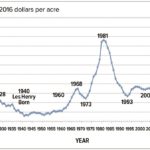
Tag Archives Soils and Crops

Getting to the root of the matter
For a look at the big picture, the ‘old’ research on roots is still relevant today

Precision ag may not work on your farm
In the field, precision ag does not yet live up to the hype that has surrounded it

Simplifying phosphorus
Experts’ opinion on P fertilizer have changed over time, and are still changing now

Looking for solutions for fusarium
Fusarium head blight is on the rise, and Les Henry is looking for a solution

Planning fertilizer for forage crops
Some food for thought on fertilization to establish forage crops in your fields

Make sure you mind your fertilizer Ps and Ks
The fertilizer story — why a pound of phosphorus may not really be a pound of phosphorus

Les Henry’s prairie stubble soil moisture map
In the map of November 2016 soil moisture, there are no “very dry” areas

90 years of Saskatchewan farmland prices
Saskatchewan land prices have been on the move since 1968. What’s next?

A convert to long-term experiments
Soil fertility is a long-term prospect that calls for long-term approaches to research

Diary of a Les Henry barley crop
This 82 bu/ac malt barley crop near Dundurn, Sask., made malt. Hurrah!


